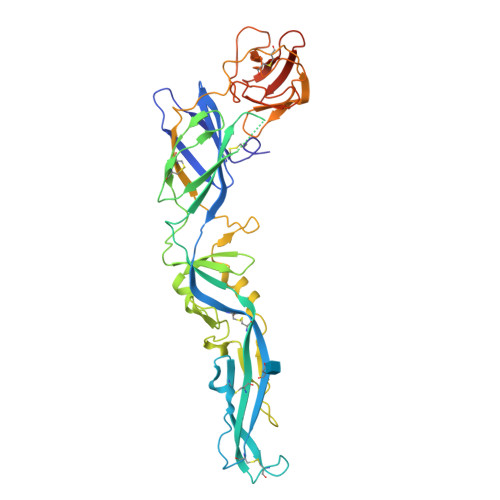Designed, highly expressing, thermostable dengue virus 2 envelope protein dimers elicit quaternary epitope antibodies.
Kudlacek, S.T., Metz, S., Thiono, D., Payne, A.M., Phan, T.T.N., Tian, S., Forsberg, L.J., Maguire, J., Seim, I., Zhang, S., Tripathy, A., Harrison, J., Nicely, N.I., Soman, S., McCracken, M.K., Gromowski, G.D., Jarman, R.G., Premkumar, L., de Silva, A.M., Kuhlman, B.(2021) Sci Adv 7: eabg4084-eabg4084
- PubMed: 34652943
- DOI: https://doi.org/10.1126/sciadv.abg4084
- Primary Citation of Related Structures:
6WY1 - PubMed Abstract:
Dengue virus (DENV) is a worldwide health burden, and a safe vaccine is needed. Neutralizing antibodies bind to quaternary epitopes on DENV envelope (E) protein homodimers. However, recombinantly expressed soluble E proteins are monomers under vaccination conditions and do not present these quaternary epitopes, partly explaining their limited success as vaccine antigens. Using molecular modeling, we found DENV2 E protein mutations that induce dimerization at low concentrations (<100 pM) and enhance production yield by more than 50-fold. Cross-dimer epitope antibodies bind to the stabilized dimers, and a crystal structure resembles the wild-type (WT) E protein bound to a dimer epitope antibody. Mice immunized with the stabilized dimers developed antibodies that bind to E dimers and not monomers and elicited higher levels of DENV2-neutralizing antibodies compared to mice immunized with WT E antigen. Our findings demonstrate the feasibility of using structure-based design to produce subunit vaccines for dengue and other flaviviruses.
Organizational Affiliation:
Department of Biochemistry and Biophysics, University of North Carolina, Chapel Hill, NC 27514, USA.



















